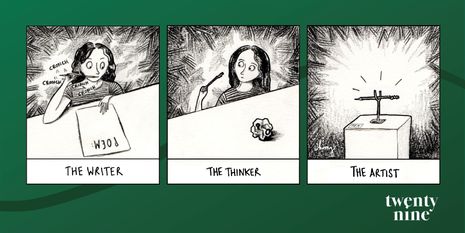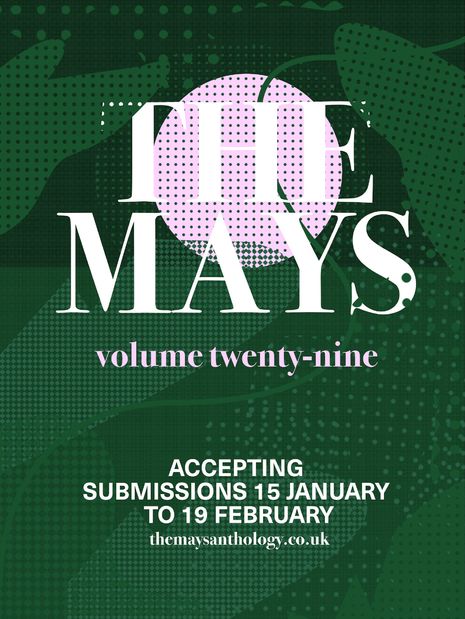The Mays 29: Still Connecting
Esmee Wright interviews Editor-in-Chief of The Mays Ceci Browning, and discusses the importance of providing a space for students to be creative together, even though we are physically apart

The act of creation has been a very different experience for us all this year. For Editor-in-Chief Ceci Browning, the pandemic has thrown up some specific issues in the creation of The Mays 29. She had been hoping to stage a huge poster campaign to entice submissions for example, but the non-return of university students put a stop to that. Instead, The Mays team, like so many others, are leaning into the world of social media, with a revitalised Instagram page and new social media strategy focusing on participation and interaction in this increasingly distanced era.
“Like everything about going to Cambridge this year, The Mays will operate slightly differently”
Social media has, after all, been a central space during the pandemic; the organic growth of social media pages like the Cambridge arts group have proven that there exists a need among students for the space to express themselves, beyond their bedroom walls – and Browning wants The Mays to provide them with such an opportunity. The Mays 29 remains un-themed, but Browning wants it to provide a space for both Cambridge and Oxford students to come together through their work, and remember that “even if we are not all in the same space, and everything else seems a bit pear-shaped, we can come together.”
Previous contributors have certainly found this aspect of The Mays deeply meaningful, as the lockdowns continue to roll around – as Imani Thompson remembered:

“I initially knew of The Mays as being the publication that launched the career of Zadie Smith, and so was curious about the journal before starting at Cambridge. Then, when I should have been writing dull essays on Medieval Literature, I wrote two pieces specifically for The Mays 28 instead.
Amidst the strange gloom of the first lockdown it was exciting to get the bright beautiful book through the letterbox. It had been so well thought through, designed, and organised – and I must admit it gave me a buzz to see my name in print. I’m just waiting for a publisher to come knocking, Zadie said it would be any day now.”
This promise of something more – not only a connection with the current Mays community, but the more permanent sensation of seeing your name in print, and even an idle dream of the future, when each day can feel quite repetitive, is part of the magic of getting published in The Mays.
Luckily, the pandemic won’t have too much of an effect for anyone thinking of submitting to The Mays. Submissions have always been a fairly distanced experience – they are selected anonymously by the team (except the actual submissions officer, Ella Tasker). For Browning, everyone should be encouraged to submit for that reason alone; the worst that could happen is an utterly anonymous rejection, and no wandering embarrassment needed, and at best well, you could be the next Zadie Smith. There is very little to lose.
And if, unlike those motivation articles, the pandemic has not brought you the glories of creativity, she emphasises, they still want to see the artwork that you have created from years ago — there is no time limit on art. It doesn’t have to be pandemic-themed at all. The Mays accepts a huge variety of styles of art, and the team are more than happy to answer any questions you might have surrounding submissions – there is even a Facebook event happening on the 5th of February should you have any burning questions to ask.
Like everything about going to Cambridge this year, The Mays will operate slightly differently. Nobody knows where we will be by 1st May, least of all the British government. However, whether or not we are able to return, The Mays will remain a testimony to the creativity of our students at this point in time, to remain so ever more.
 News / Cambridge study finds students learn better with notes than AI13 December 2025
News / Cambridge study finds students learn better with notes than AI13 December 2025 News / Cambridge Vet School gets lifeline year to stay accredited28 November 2025
News / Cambridge Vet School gets lifeline year to stay accredited28 November 2025 Science / Did your ex trip on King’s Parade? The science behind the ‘ick’12 December 2025
Science / Did your ex trip on King’s Parade? The science behind the ‘ick’12 December 2025 News / Uni Scout and Guide Club affirms trans inclusion 12 December 2025
News / Uni Scout and Guide Club affirms trans inclusion 12 December 2025 Arts / Modern Modernist Centenary: T. S. Eliot13 December 2025
Arts / Modern Modernist Centenary: T. S. Eliot13 December 2025










